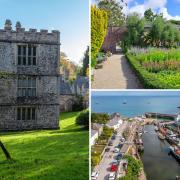Virginia Woolf spent much of their childhood at Talland House in St Ives leading to her St Ives trilogy: Jacob’s Room, To the Lighthouse and The Waves

Why am I so incredibly and incurably romantic about Cornwall?’ wondered Virginia Woolf as she anticipated the journey to the county that inspired so much of her work. CAROL BURNS finds out...
Cornwall’s landmarks make regular appearances in works of literature and popular culture – the house on the Roseland that featured in the Camomile Lawn still draws fans, the Headland Hotel was used to great effect as the film adaptation of Roald Dahl’s The Witches and Daphne Du Maurier featured Fowey and Bodmin Moor in her works – but among our most famous literary landmarks is Godrevy Lighthouse, used by Virginia Woolf in To The Lighthouse.
Virginia Woolf and her modernist stream of consciousness writing style – along with her well-publicised mental ill-health and eventual suicide - have given her novels a reputation of being difficult. This belies the beauty of her writing – much of it inspired by a childhood spent in St Ives and to which she returned again and again in her adulthood to be inspired, to write and to find solace.
In a new book, Virginia Woolf and Vanessa Bell: A childhood in St Ives, author Marion Whybrow tells the fascinating story of their early lives with fascinating insight into the town, its people and the burgeoning arts colony.

Virginia – and her sister, the artist Vanessa Bell spent much of their childhood at Talland House in St Ives – a childhood full of memories which informed her writing in the so-called St Ives trilogy: Jacob’s Room, To the Lighthouse and The Waves, Vanessa in turn was influenced by the artist colonies in Cornwall at Newlyn and the St Ives Arts Club.
The Town was then much as it must have been in the 16th century: a scramble, a pyramid of white-washed granite houses, crusting the slope made in the hollow under the Island. It was built their for shelter – built for a few fishermen, when Cornwall was a country more remote from England than Spain is now…St Ives might have been built now or in the time of the Conqueror,’ wrote Virginia Woolf in Moments of Being about St Ives. Their father Leslie Stephen discovered St Ives on a walking tour of Cornwall and bought the lease of Talland House in 1881. For several months of the year the elegant house overlooking St Ives Bay would be the Stephens’ family home until 1895 when their mother Julia died.
Probably nothing that we had as children was quite so important to us as our summer in Cornwall,’ Virginia wrote. To have our own house, our own garden – to have that bay, that sea, and the Mount; Clodgy and Halestown bog, Carbis Bay, Lelant, Zennor, Trevail, the Gurnard’s Head: to hear the waves breaking that first night behind the yellow blind, to sail in the lugger; to dig in the sand; to scramble over the rocks…I could fill pages remembering one thing after another that made the summer at St Ives the best beginning to a life conceivable.’
The harbour is well-known as an artists’ enclave, but it also attracted its fair share of writers: American novelist Henry James stayed at Tregenna Castle Hotel in the 1880s, Whisky Galore author Compton MacKenzie and Hugh Walpole visited also visited. DH Lawrence wrote Women in Love while in Cornwall and Katherine Mansfield spent time with him in a cottage in Zennor. Writers George Meredith and Sunday Tramp were regular visitors to Talland House. Many of the visits were recorded by Virginia herself in her self-penned newspaper Hyde Park Gate News.
Although the complete family never returned to St Ives following their mother’s death her children travelled back in 1905 to visit Talland House, following the death of their father in 1904. Talland House was then home to artist Thomas Millie Dow and his family. Virginia returned again to St Ives and stayed at Trevose House, Draycott Terrace in 1908 – where one local described her as a bit of an eccentric’.
Later as an adult, Virginia Woolf sought out Cornwall has a happy place to recover during bouts of ill health which often followed completion of a book. Such was the pull of Cornwall that one day she gets on a train from London, despite having no coat, chequebook or spectacles. I went for a walk in Regent’s Park yesterday morning, and it suddenly struck me how absurd it was to stay in London, with Cornwall going on all the time,’ she records of her sudden train journey from London to Cornwall in 1909. I have been walking along the sands and sitting in the sun… I am so drugged with fresh air that I can’t write…As for the beauty of this place it surpasses every other season.’
Virginia Woolf: The St Ives Trilogy
Jacob’s Room (1922) is Woolf's first modernist novel and feeatures family holidays in Cornwall
To The Lighthouse (1927) recreates her childhood at Talland House in Cornwall – and the view of St Ives Bay towards Godrevy Lighthouse. The Stephens family are recreated as The Ramseys with a petty, selfish, vain, egotistical’ father who wears his wife to death’.
The Waves (1931) is an experimental series of soliloquies broken up by a coastal scene in varying stages in a day from sunrise to sunset.



























